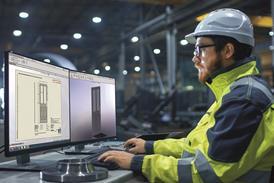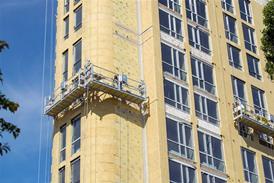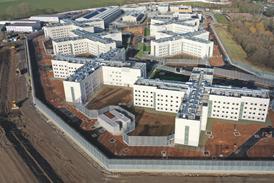Power track has many advantages over cabling, this is why firms such as Ernst & Young are having underfloor trunking installed in their offices. The accounting firm has opted for the system in its new offices, which are under construction in the More London complex alongside Tower Bridge. Some 4·5 km of Ackermann underfloor track is scheduled to be installed in the building before its completion in Summer 2003.
Recently completed projects that have similar lengths of underfloor track include the Capital One call centre in Nottingham, which has been fitted with nearly 3 km of Ackermann track, and the Misco distribution centre in Wellingborough, where about 1 km of track serves over 300 computers.
In the Misco installation, the power supplies fed by the underfloor track are protected against earthing problems by using specially designed desks in order to meet Regulation 607 of the IEE Wiring Regulations (BS 7671: 2001).
Such high integrity earthing can be provided in various ways, for example by using socket outlets with two earthing terminals, which are standard in Ackermann floor boxes. In the Misco installation it was considered that safety would be enhanced if the dual-earth sockets were at desk level, fed by duplicate leads from the tap-offs, with the leads built into the desks.
Underfloor power track may be more expensive than cabling but it has the advantages of being quicker to install, and the connections to relocated desks are easier and faster to make. Underfloor power track also needs very little maintenance; it is compact and self-contained and is easily adapted to meet the changing needs of the user. It comes in lengths that can be easily connected to suit individual needs, and the need for the installer to allow for the bending radii of cables is removed.
Power on demand
Cables are more manoeuvrable than power track and can follow the contours of a building. However, even though power track is laid in straight lines it can be tapped-off along its length at intervals as short as 150 mm.
Spacing between the track depends on the service density needed, tap-off lengths and the degree of flexibility needed: a good average is 4·8 m. Where a floor is to be flood-wired to meet future churn the use of track with socket outlets for tap-offs every 150 mm is recommended. Other options include socket outlets at 600 and 300 mm pitches.
The selection of tap-offs from some manufacturers is huge. Ackermann, for example, offers 200 variations – 13 or 32A – with three or five metre leads of 1·5 or 4 mm2 low smoke and fume cable. Tap-off plugs are colour-coded to ensure that incompatible connections are not made accidentally. Tap-off options are also available to meet the requirements of IEE Regulation 607 in BS7671 concerning high integrity earthing.
Snap decision
Tracks are available with patented crocodile snap-fast joints for fast installation without the need for special tools and with minimum use of skilled labour. It is a good idea to select a brand with key-coded joints to ensure that only matching amperages are connected; 40 and 63 A versions are offered, catering for single, multi-phase or multi-circuit applications. These are suitable for standard, clean earth, uninterrupted or dedicated power supply up to 500 V.
In areas where harmonics may occur due to non-linear loads from computers, data transfer equipment and electronic lighting systems, it is advisable to use track with a double-neutral conductor if maximum performance is required.
The track is mounted to the slab in the underfloor void on adjustable brackets that allow it to be raised to clear other cables and services. The need for this clearance is sometimes overlooked. With this in mind, Ackermann has introduced a new range of cable distribution floor boxes that are among the shallowest on the market. These measure 362 mm long by 242 mm wide and include a standard 40 mm-deep accessory box. They are available in three versions, with depths of 80, 90 and 120 mm.
The shallowest unit is suited to areas where the underfloor cavity is either too shallow or too full with services to allow for floor boxes to be installed immediately above the track and cable serving it. Such situations are becoming increasingly common in the modern office environment.
The new floor boxes are fast and easy to install and can take up to four power and data socket modules. They are supplied off-the-shelf with four modules or three modules and space for a fourth to be inserted at a later date. While not in use, this space is covered by a moulded expansion plate.
No tools are needed to install the frame assembly into the floor tile. It is simply dropped into the aperture and the release of a patented, spring-loaded blade mechanism holds it securely in position.
An optional feature is a cable dump, designed to enable excess cabling provided for possible future desk connections to be stored safely away within the floor box. The cable dump is designed for use with triple-module boxes. It is a wire meshed, flexible container that fits easily into the fourth module position. It is offered as an alternative to the expansion plate. By storing the cable in this unit, the office floor is made tidier and the potential for people tripping over cable is greatly reduced.
Cables from tap-offs can also be accessed via grommets. These can be used to create an underfloor termination point for fixed wiring or they may be fitted with standard or clean earth 13 A sockets. Voice and data options are also available.
Adapting to needs
For one particular project, Ackermann, in conjunction with the project consultants, designed a special grommet housing a triple voice and data outlet and a dual six-pin power socket. This has been used to replace floor boxes in the underfloor track system installed in the new corporate headquarters of a major petrochemical firm.
The firm moved into the London office earlier this year following a fit-out that included the updating of existing Ackermann underfloor power track. With a working area of over 9300 m2 on eight floors, the building provides office accommodation for directors and senior executives, plus the teams responsible for shaping and driving group strategy and performance, numbering in total around 200 people. Up to one-third of the building provides conference facilities, meeting rooms and flexible office space for visiting executives.
To meet the power needs on each floor while providing maximum flexibility, the individual floors have been flooded on the basis of 2·5 m grid with Duo six-pin power sockets fed from Ackermann underfloor Interact track. RJ54 voice and data outlets are fed by separate IT cable. The outlet units lie on the slab and are connected to the appropriate connectors in the bespoke grommets when required.
A typical floor in the building has 225 m of track in 25 separate lengths, ranging between 4·6 and 12 m. These are made up from 1·2, 2·4 and 3·6 m tracks supplied by Ackermann to fit the different shapes and dimensions of space available. Each track has an outlet every 150 mm and the space between the tracks is 4 m.
Source
Electrical and Mechanical Contractor
Postscript
Peter Smith is the national sales manager for Ackermann.




















No comments yet